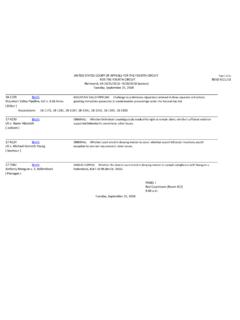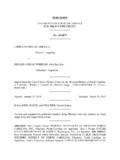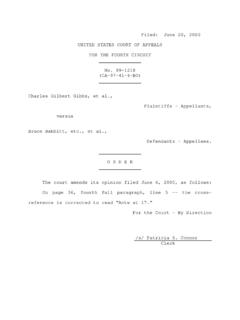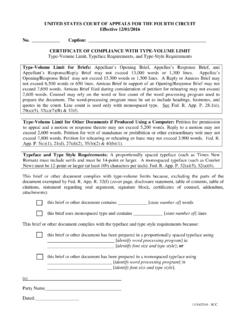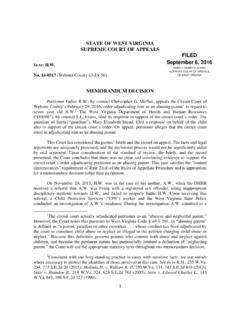Transcription of PUBLISHED - ca4.uscourts.gov
1 PUBLISHED UNITED STATES court OF APPEALS FOR THE FOURTH CIRCUIT No. 17-6746 LEE BOYD MALVO, Petitioner - Appellee, v. RANDALL MATHENA, Chief Warden, Red Onion State Prison, Respondent - Appellant. ----------------------------- HOLLY LANDRY, Amicus Supporting Appellee. No. 17-6758 LEE BOYD MALVO, Petitioner - Appellee, v. RANDALL MATHENA, Chief Warden, Red Onion State Prison, Respondent - Appellant. ----------------------------- 2 HOLLY LANDRY, Amicus Supporting Appellee. Appeals from the United States District court for the Eastern District of Virginia, at Norfolk. Raymond A. Jackson, District Judge. (2:13-cv-00375-RAJ-LRL; 2:13-cv -00376-RAJ-LRL) Argued: January 23, 2018 Decided: June 21, 2018 Before NIEMEYER, KING, and DIAZ, Circuit Judges. Affirmed by PUBLISHED opinion.
2 Judge Niemeyer wrote the opinion, in which Judge King and Judge Diaz joined. ARGUED: Matthew Robert McGuire, OFFICE OF THE ATTORNEY GENERAL OF VIRGINIA, Richmond, Virginia, for Appellant. Craig Stover Cooley, Richmond, Virginia, for Appellee. ON BRIEF: Mark R. Herring, Attorney General, Trevor S. Cox, Acting Solicitor General, Donald E. Jeffrey III, Senior Assistant Attorney General, OFFICE OF THE ATTORNEY GENERAL OF VIRGINIA, Richmond, Virginia, for Appellant. Michael Arif, ARIF & ASSOCIATES, , Fairfax, Virginia, for Appellee. Danielle Spinelli, Beth C. Neitzel, WILMER CUTLER PICKERING HALE AND DORR LLP, Washington, , for Amicus Curiae. 3 NIEMEYER, Circuit Judge: In Virginia in 2004, a defendant convicted of capital murder, who was at least 16 years old at the time of his crime, would be punished by either death or life imprisonment without the possibility of parole, unless the judge suspended his sentence.
3 After a Virginia jury convicted Lee Boyd Malvo of two counts of capital murder based on homicides that he committed in 2002 when he was 17 years old, it declined to recommend the death penalty, and he was instead sentenced in 2004 to two terms of life imprisonment without parole, in accordance with Virginia law. Thereafter, Malvo, again seeking to avoid the death penalty, pleaded guilty in another Virginia jurisdiction to one count of capital murder and one count of attempted capital murder both of which he also committed when 17 years old and received two additional terms of life imprisonment without parole. After Malvo was sentenced in those cases, the supreme court issued a series of decisions relating to the sentencing of defendants who committed serious crimes when under the age of 18. It held that such defendants cannot be sentenced to death; that they cannot be sentenced to life imprisonment without parole unless they committed a homicide offense that reflected their permanent incorrigibility; and that these rules relating to juvenile sentencing are to be applied retroactively, meaning that sentences that were legal when imposed must be vacated if they were imposed in violation of the court s new rules.
4 See Roper v. Simmons, 543 551 (2005); Graham v. Florida, 560 48 (2010); Miller v. Alabama, 567 460 (2012); Montgomery v. Louisiana, 136 S. Ct. 718 (2016). 4 In these habeas cases filed under 28 2254, we conclude that even though Malvo s life-without-parole sentences were fully legal when imposed, they must now be vacated because the retroactive constitutional rules for sentencing juveniles adopted subsequent to Malvo s sentencings were not satisfied during his sentencings. Accordingly, we affirm the district court s order vacating Malvo s four terms of life imprisonment without parole and remanding for resentencing to determine (1) whether Malvo qualifies as one of the rare juvenile offenders who may, consistent with the Eighth Amendment, be sentenced to life without the possibility of parole because his crimes reflect permanent incorrigibility or (2) whether those crimes instead reflect the transient immaturity of youth, in which case he must receive a sentence short of life imprisonment without the possibility of parole.
5 Montgomery, 136 S. Ct. at 734. I A Over the course of almost seven weeks in the fall of 2002, Lee Malvo and John Muhammad better known as the Snipers murdered 12 individuals, inflicted grievous injuries on 6 others, and terrorized the entire Washington, metropolitan area, instilling an all-consuming fear into the community. The violence began on September 5, 2002, when Malvo who was at the time 17 years old ran up to a man s car in Clinton, Maryland, shot him six times with a .22 caliber handgun, and stole his laptop and $3,500 in cash. See Muhammad v. Kelly, 575 359, 362 (4th Cir. 2009). Ten days later, again in Clinton, Maryland, Malvo 5 approached a man who was in the process of closing a liquor store and shot him in the abdomen at close range with the handgun. Id. Muhammad and Malvo then went south for a short period. On September 21, Muhammad used a high-powered, long-range Bushmaster assault rifle to shoot two women who had just closed a liquor store in Montgomery, Alabama.
6 Malvo was seen approaching the women as the shots were being fired and then rummaging through their purses. One of the women died from her wounds. Muhammad, 575 at 362. Two days after that, a woman in Baton Rouge, Louisiana, was fatally shot in the head with a Bushmaster rifle after closing the store where she worked. Again, Malvo was seen fleeing the scene with her purse. Id. at 362 63. Shortly thereafter, Muhammad and Malvo returned to the Washington, area and, from October 2 until their capture on October 24, embarked on a series of indiscriminate sniper shootings with the Bushmaster rifle that left 10 more people dead, 3 seriously wounded, and the entire region gripped by a paroxysm of fear, convinced that every man, woman, and child was a likely target. Muhammad v. State, 934 1059, 1065 66 (Md. Ct. Spec. App. 2007). On October 2, shortly after 6 , they shot and killed a man while he was in a grocery store parking lot in Montgomery County, Maryland.
7 Id. at 1066. The next day, they murdered five people four in the morning at different locations in Montgomery County, and a fifth that evening in Washington, Id. at 1067 69. The following day, they shot and seriously wounded a woman in Spotsylvania County, Virginia, while she was loading goods into her car. Id. at 1070. On October 7, they shot and gravely injured a 13-year-old boy in Prince George s 6 County, Maryland, while he was on his way to school; two days later, they shot and killed a man at a gas station in Prince William County, Virginia; two days after that, they shot and killed another man at a gas station in Spotsylvania County, Virginia; and three days after that, they shot and killed a woman outside a Home Depot store in Fairfax County, Virginia. Id. at 1070 72. On October 19, they shot and seriously wounded a man while he was leaving a restaurant in Ashland, Virginia, and on October 22, they shot and killed a bus driver in Montgomery County, Maryland, the last of their sniper shootings.
8 Id. at 1068, 1072. Malvo and Muhammad were apprehended in the early hours of October 24 at a rest area in Frederick County, Maryland, while sleeping in a blue Chevrolet Caprice. A loaded .223 caliber Bushmaster rifle was found in the car, and a hole had been cut into the lid of the trunk, just above the license plate, through which a rifle barrel could be projected. Muhammad, 934 at 1075. Modifications had also been made to the car s rear seat to allow access to the trunk area from the car s passenger compartment. Id. After his arrest, Malvo told authorities in Virginia that he and his father, John Allen Muhammad, had acted as a sniper team .. in an effort to extort ten million dollars from the media and the government and that he had been the triggerman in 10 of the shootings. Later, however, when testifying as a witness at Muhammed s first-degree murder trial in Montgomery County, Maryland, Malvo stated that he had been the actual shooter of [the 13-year old boy] in Prince George s County and of [the bus driver] in Montgomery County and that Muhammad had been the actual triggerman on all other occasions.
9 Id. at 1078. 7 In January 2003, a grand jury in Fairfax County, Virginia, returned an indictment charging Malvo as an adult with (1) capital murder in the commission of an act of terrorism, in violation of Va. Code Ann. (13); (2) capital murder for killing more than one person within a three-year period, in violation of (8); and (3) using a firearm in the commission of a felony, in violation of The prosecutor in that case sought the death penalty. Malvo pleaded not guilty to the charges, and, to ensure an impartial jury pool, the case was transferred to the Circuit court for the City of Chesapeake, Virginia. At the trial, which took place during November and December 2003, Malvo acknowledged his involvement in the killings but asserted an insanity defense based on the theory that he had been indoctrinated by Muhammad during his adolescence and was operating under Muhammad s control.
10 To that end, defense counsel presented testimony from more than 40 witnesses who collectively described how Malvo was physically abused and largely abandoned as a child growing up in Jamaica and Antigua; how, when he was 15 years old, he befriended John Muhammad, an American veteran who had taken his three children to live in Antigua without their mother s knowledge; how Muhammad became a surrogate father for Malvo and brought him illegally to the United States in May 2001; how Malvo briefly reunited with his mother in the United States but then moved across the country in October 2001 to rejoin Muhammad, who had recently lost custody of his children; and how Muhammad then intensively trained Malvo in military tactics for nearly a year, telling Malvo that he had a plan to get his children back and 8 force America to reckon with its social injustices. The jury rejected Malvo s insanity defense and convicted him of all charges, including the two capital murder charges.
